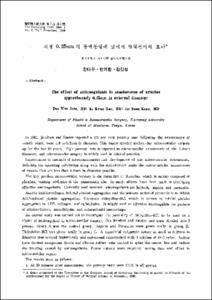외경 0.25mm의 동맥문합에 있어서 항혈전제의 효과
- Keimyung Author(s)
- Han, Ki Hwan; Kang, Jin Sung
- Department
- Dept. of Plastic Surgery (성형외과학)
- Journal Title
- Keimyung Medical Journal
- Issued Date
- 1988
- Volume
- 7
- Issue
- 2
- Abstract
- In 1960, Jacobson and Suarez reported a 100 per cent patency rate following the anastomoses of vessels which were 1.6 to 3.2 mm in diameter. This report speeded modern-day microvascular surgery up for the last 20 years. High patency rate is reported in microvascular anastomosis of the 1.0mm diameter, and microvascular surgery is widely used in clinical practice. Improvement in methosds of microanastomoses and development of the microvascular instruments, including the operating microscope along with the microsutures make the microvascular anastomoses of vessels that are less than 0.5mm in diameter opssible. The key problem microvascular surgery is the formation of thrombus which is mainly composed of platelets, causing occlusion of the anastomotic site. So much efforts have been made in developing effective anticoagulants. Currently used systemic anticoagulants are heparin, aspirin and persantin. Aspirin inhibits collagen-induced platelet aggregation and the primary action of persanin is to inhibit platelet aggregation to ADP, collagen, and epinephrine, is widely used as effective anticoagulant for patients of atherosclerosis, hemodialysis, and subarachnoid hemorrhage. An animal study was carried out to investigate the opssibility of tichlopidine-HCI to be used as a choice of anticoagulant in microvascular surgery. One hundred and twenty rats were divided into 3 groups. Group A was the control group. Aspirin and Persantin were given orally in group B. Ticlopidine-HCI was given orally in group C. A superficial epigastric artery as small as 0.25mm in hage devised autogenous fascia and silicone rubber tube method to splint the suture line and reduce the bleeding casued by anticoagulants. Fewer sutures were required, saving time and effort in microvascular repair. The results were as follows: 1. At 20 minutes after anastomoses, the patency rates were 100% in all groups. 2. At 3 days after anastomoses, the patency rates were 75% in the control group(A), 75% in the aspirin-persanting group(B), and 80% in the ticlopidine group(C). 3. At 3 weeks after anastomoses, the patency rates were 70% in the group A, 75% in the group B, and 80% in the group C. It is concluded that the ticlopidine-HCI may be used in the microvascular anastomoses of very small arteries as the anticoagulant of choice.
- Alternative Title
- The effect of anticoagulants in anastomoses of arteries approximately 0.25mm in external diameter
- Publisher
- Keimyung University School of Medicine
- Citation
- 전대우 et al. (1988). 외경 0.25mm의 동맥문합에 있어서 항혈전제의 효과. Keimyung Medical Journal, 7(2), 227–235.
- Type
- Article
- Appears in Collections:
- 2. Keimyung Medical Journal (계명의대 학술지) > 1988
1. School of Medicine (의과대학) > Dept. of Plastic Surgery (성형외과학)
Items in Repository are protected by copyright, with all rights reserved, unless otherwise indicated.
